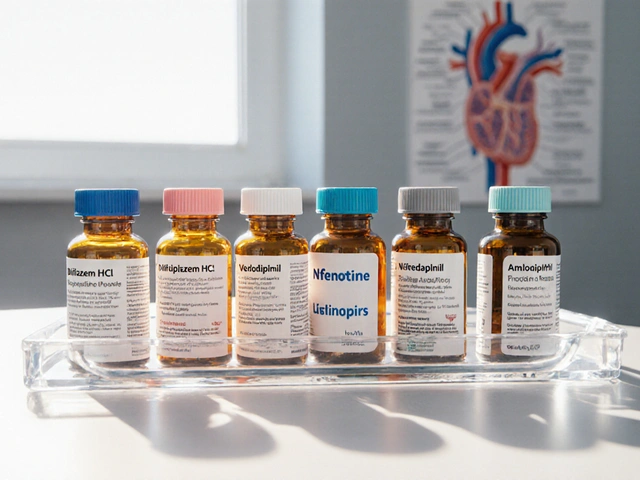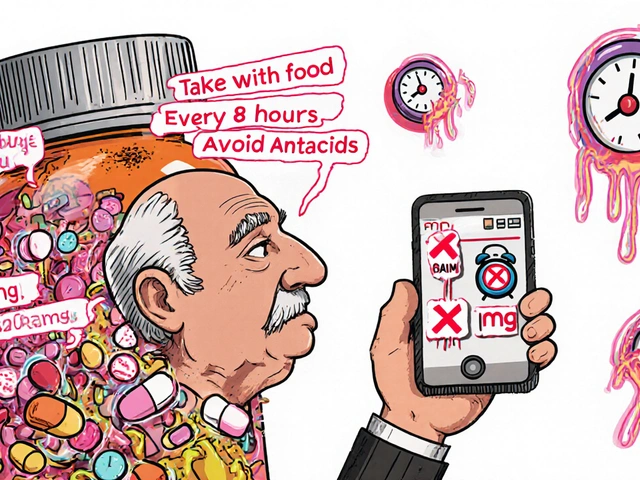Migraine & Vertigo Treatment Selector
Recommended Treatment Options
Key Considerations
Quick Takeaways
- Flunarizine comparison: effective for migraine and vestibular disorders, but weight gain and depression are common concerns.
- Top alternatives include topiramate, amitriptyline, propranolol, verapamil, acetazolamide, and metoprolol.
- Choice depends on headache type, co‑existing conditions, side‑effect profile, and pregnancy status.
- Most alternatives share a daily oral dose, but mechanisms range from calcium‑channel blockade to beta‑blockade and carbonic‑anhydrase inhibition.
- Regular follow‑up (4‑6weeks) helps fine‑tune dose and catch adverse effects early.
What is Flunarizine (Sibelium)?
When treating migraine or balance problems, Flunarizine is a selective calcium channel blocker sold under the brand name Sibelium, approved for migraine prophylaxis and vestibular disorders. It works by stabilising neuronal membranes and reducing calcium influx, which dampens the hyper‑excitability that triggers migraine attacks.
Typical adult dosage is 5mg once daily, taken in the evening to minimise daytime drowsiness. Effects usually appear after 2-4weeks of consistent use.
Why might you need an alternative?
Flunarizine is well‑tolerated for many, but several factors push patients toward other options:
- Weight gain (up to 5kg in 6months) reported in up to 15% of users.
- Depressive symptoms or mood swings, especially in people with a history of mental health issues.
- Contraindications: severe liver disease, Parkinson’s disease, or pregnancy (Category C).
- Drug interactions with other calcium antagonists or CYP2C9 inhibitors.
If any of these apply, considering a different preventive medication can improve adherence and quality of life.
Top Alternatives Overview
Below is a quick glance at the most frequently prescribed substitutes. Each entry includes the drug’s class, primary mechanism, and key clinical notes.
Topiramate - Antiepileptic
Topiramate blocks sodium channels and enhances GABA activity, which reduces cortical spreading depression-one of the triggers for migraine aura. The usual prophylactic dose starts at 25mg nightly and titrates up to 100mg daily.
Advantages: strong evidence for both migraine with and without aura; can also aid weight loss.
Drawbacks: paresthesia, cognitive fog, and a small risk of kidney stones.
Amitriptyline - Tricyclic Antidepressant
Amitriptyline modulates serotonin and norepinephrine reuptake while also blocking histamine receptors, which can alleviate both headache and tension‑type pain. Starting dose is 10-25mg at bedtime, increasing to 50-150mg as tolerated.
Best for patients who also suffer from insomnia or chronic neck pain.
Watch for dry mouth, constipation, and potential cardiac conduction delays.
Propranolol - Non‑selective Beta‑Blocker
Propranolol reduces sympathetic nervous system activity, lowering the frequency of migraine attacks. Typical prophylactic dosing ranges from 40mg twice daily up to 240mg total.
Especially useful for patients with hypertension or performance anxiety.
Contraindicated in asthma, severe bradycardia, and decompensated heart failure.
Verapamil - Calcium Channel Blocker (Dihydropyridine‑type)
Verapamil inhibits L‑type calcium channels, which can dampen vascular smooth‑muscle contraction linked to migraine. Doses start at 80mg three times daily, maxing at 480mg.
Favoured for cluster headaches and menstrual‑related migraine.
Potential side effects include constipation and slight heart‑rate reduction.
Acetazolamide - Carbonic Anhydrase Inhibitor
Acetazolamide decreases cerebrospinal fluid production, helping with episodic vertigo and certain migraine subtypes. The usual dose is 250mg twice daily.
Works well for patients with Ménière’s disease‑related vertigo.
Common issues: tingling of extremities, renal stone formation, and metabolic acidosis.
Metoprolol - Cardioselective Beta‑Blocker
Metoprolol selectively blocks β1‑adrenergic receptors, offering migraine protection with fewer respiratory side effects than propranolol. Starting dose is 50mg once daily, titrating to 200mg.
Ideal for patients who also need blood‑pressure control but cannot tolerate non‑selective beta‑blockers.
Monitor for fatigue and occasional depression.
Side‑by‑Side Comparison
| Drug | Class | Primary Mechanism | Typical Prophylactic Dose | Common Side Effects | Notable Contraindications |
|---|---|---|---|---|---|
| Flunarizine | Calcium‑channel blocker | L‑type Ca²⁺ channel inhibition | 5mg nightly | Weight gain, drowsiness, depression | Pregnancy, severe liver disease |
| Topiramate | Antiepileptic | Sodium‑channel blockade, GABA potentiation | 25‑100mg daily | Paresthesia, cognitive slowing, kidney stones | Pregnancy (Category D) |
| Amitriptyline | Tricyclic antidepressant | Serotonin & norepinephrine reuptake inhibition | 10‑150mg nightly | Dry mouth, constipation, cardiac conduction delay | Recent MI, uncontrolled arrhythmia |
| Propranolol | Non‑selective beta‑blocker | β‑adrenergic blockade | 40‑240mg daily | Fatigue, cold extremities, sleep disturbances | Asthma, bradycardia, severe heart failure |
| Verapamil | Calcium‑channel blocker | L‑type Ca²⁺ channel inhibition (vascular) | 80‑480mg daily | Constipation, mild hypotension | Severe LV dysfunction, AV block |
| Acetazolamide | Carbonic anhydrase inhibitor | Reduced CSF production | 250mg BID | Tingling, metabolic acidosis, renal stones | Severe liver disease, sulfonamide allergy |
| Metoprolol | Cardioselective beta‑blocker | β1‑adrenergic blockade | 50‑200mg daily | Fatigue, depression, occasional bradycardia | Severe bradycardia, AV block, decompensated HF |

How to Choose the Right Preventive Medication
Think of the decision as a checklist rather than a lottery. Ask yourself these questions:
- What is the dominant symptom? Pure migraine, vestibular vertigo, or a mix?
- Do I have comorbid conditions? Hypertension, depression, asthma, or kidney issues steer the choice.
- How sensitive am I to weight changes? Flunarizine and amitriptyline can add pounds; topiramate may actually help lose weight.
- Am I planning a pregnancy? Avoid Flunarizine, propranolol (non‑selective) and topiramate; consider metoprolol or low‑dose amitriptyline under supervision.
- What is my budget and insurance coverage? Generic versions of propranolol and metoprolol are cheap; branded Sibelium can be pricier.
Match the answers to the drug profile in the table above. If multiple options fit, start with the one that addresses any secondary health issue you already have (e.g., hypertension → propranolol).
Practical Tips & Monitoring
- Give any new preventive at least 8weeks before judging effectiveness.
- Maintain a headache diary: date, severity (0‑10), triggers, and medication taken.
- Schedule a follow‑up visit at 4‑6weeks for dose adjustment and side‑effect review.
- Check liver enzymes if you stay on Flunarizine for longer than 6months.
- For beta‑blockers, monitor heart rate and blood pressure each month.
Frequently Asked Questions
Can I switch from Flunarizine to another drug without a washout period?
Generally you can transition directly, but tapering the dose over one week reduces the chance of rebound headaches. Always discuss the plan with your prescriber.
Is Flunarizine safe for people over 65?
Caution is advised. Age‑related liver changes can increase drug levels, and the risk of dizziness and falls goes up. A lower dose (2.5mg) or an alternative like propranolol is often preferred.
Why does Flunarizine cause weight gain?
Its antihistamine activity can increase appetite, while the sedating effect reduces overall activity. Lifestyle coaching can counteract the extra calories.
Which alternative works best for vertigo‑related migraine?
Acetazolamide and topiramate have the strongest evidence for vestibular migraine. If you also need blood‑pressure control, metoprolol is a solid compromise.
Do any of these drugs interact with common OTC pain relievers?
Most are safe with standard ibuprofen or paracetamol. However, combining topiramate with high‑dose NSAIDs can increase kidney strain, and beta‑blockers may amplify the blood‑pressure‑lowering effect of NSAIDs in sensitive individuals.







Mayra Oto
October 10, 2025 AT 19:57I’ve been using Flunarizine for a while and found it does help cut down the migraine frequency, but the drowsiness can be a real nuisance on busy mornings.
Balancing the dose in the evening usually eases the daytime fog, though you still have to watch your weight.
S. Davidson
October 11, 2025 AT 07:04Honestly, the data you posted is cherry‑picked; most patients experience more side‑effects than the benefits you’re highlighting, especially the depressive symptoms that many clinicians downplay.
Haley Porter
October 11, 2025 AT 18:11From a pharmacodynamic perspective, the calcium‑channel blockade exerted by Flunarizine is a double‑edged sword; it attenuates neuronal hyperexcitability, yet it simultaneously interferes with histaminergic pathways, which accounts for the somnolence and appetite modulation seen in clinical cohorts.
Moreover, the drug’s lipophilicity facilitates CNS penetration, conferring efficacy for vestibular migraine but also predisposing to central adverse events.
In the context of comorbid depression, the antagonism of serotonergic transmission should raise red flags for clinicians.
Population‑based studies have reported a 12‑15% incidence of mood disturbances, a figure that eclipses the 5% often quoted in manufacturer literature.
Furthermore, the metabolic clearance via CYP2C9 introduces variability; polymorphic expression can lead to supratherapeutic plasma concentrations, exacerbating weight gain.
Therapeutic drug monitoring is rarely performed, leaving physicians to rely on symptomatology alone.
The dosing schedule of 5 mg nightly aims to synchronize with the circadian nadir of cortical excitability, yet adherence wanes when patients feel the sedative effect persists into the morning.
Switching to a beta‑blocker, such as propranolol, might mitigate these issues for hypertensive patients, but the risk of bradycardia remains.
Alternatives like topiramate provide weight‑loss benefits, though they bring cognitive fog and paresthesia into the equation.
Amidst this therapeutic labyrinth, shared decision‑making becomes paramount; patients should be apprised of both efficacy and the full spectrum of adverse outcomes.
In the elderly, dose reduction to 2.5 mg is advisable to curtail falls risk linked to dizziness.
Pregnancy contraindications are well‑documented, reinforcing the necessity of preconception counseling.
Overall, the clinician must weigh the modest prophylactic advantage against the substantive side‑effect burden, tailoring therapy to individual comorbidity profiles.
Samantha Kolkowski
October 12, 2025 AT 05:17I think the table summary is super handy – having all the key facts side by side makes it easier to compare without scrolling through paragraphs.
Gauri Omar
October 12, 2025 AT 16:24Drama alert! Imagine battling a migraine while your scale keeps creeping upward – it's like fighting two dragons at once! Flunarizine may be a hero for some, but for many it feels like a villain in disguise, sneaking on extra pounds and moody clouds. If you’re already wrestling with depression, adding this drug is like tossing gasoline on a fire. Switch it up before you become a walking tragedy.
Willy garcia
October 13, 2025 AT 03:31Quick tip: keep a headache diary and note which meds you’re on, the dosage, and any side effects – it helps your doc fine‑tune the treatment fast.
zaza oglu
October 13, 2025 AT 14:37That diary idea is golden! 🎉 It’s like having a personal health GPS, guiding you straight to the right meds without guessing.
Vaibhav Sai
October 14, 2025 AT 01:44One thing to remember is the importance of checking liver enzymes if you stay on Flunarizine longer than six months; hepatic accumulation can sneak up.
Lindy Swanson
October 14, 2025 AT 12:51Honestly, I’ve seen people stick with the same drug for years just because switching feels scary, but sometimes the side‑effects are worth the hassle of a change.
Amit Kumar
October 14, 2025 AT 23:57Love how the post breaks down each alternative – super helpful! 😄 If you’re worried about weight gain, topiramate’s the go‑to, but watch out for kidney stones.
Crystal Heim
October 15, 2025 AT 11:04The weight‑loss claim of topiramate is overhyped; many patients end up with cognitive slowdown that outweighs a few lost pounds.
Sruthi V Nair
October 15, 2025 AT 22:11If you have both migraine and anxiety, a beta‑blocker like metoprolol can kill two birds with one stone, but keep an eye on fatigue.
Mustapha Mustapha
October 16, 2025 AT 09:17Totally agree – metoprolol’s a solid choice for those with hypertension, though the occasional low heart rate can be a nuisance.
Ben Muncie
October 16, 2025 AT 20:24Flunarizine isn’t for everyone.
kevin tarp
October 17, 2025 AT 07:31Grammar point: the article should say “a migraine” not “the migraine” when referring to the condition in general.
ravi kumar
October 17, 2025 AT 18:37From an Indian perspective, many patients still rely on older generics due to cost, so availability of cheap propranolol makes it a popular first‑line despite its side‑effect profile.
SandraAnn Clark
October 18, 2025 AT 05:44Looks like another “new drug” hype to me.
Rex Wang
October 18, 2025 AT 16:51Thanks for the thorough breakdown – it really helps me feel less overwhelmed about choosing a preventive.